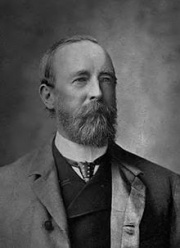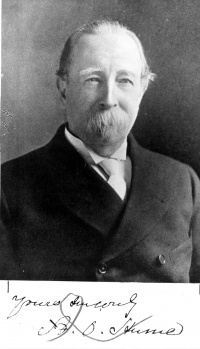Allan Octavian Hume: Difference between revisions
Pablo Sender (talk | contribs) |
Pablo Sender (talk | contribs) |
||
| Line 41: | Line 41: | ||
== Theosophy == | == Theosophy == | ||
On 25 February 1879, soon after Helena Petrovna Blavatsky|H. P. Blavatsky]] and [[Henry Steel Olcott|Col. H. S. Olcott]] landed at Bombay, India, the editor of the influential newspaper [[The Pioneer (periodical)|The Pioneer]], [[Alfred Percy Sinnett|Mr A. P. Sinnett]], wrote to them expressing his desire to become acquainted with them, and his willingness to publish any information which they liked to give him about their mission in India. On December 2nd of that year the [[Founders]] visited Mr and Mrs Sinnett at their house in Allahabad, where they met other influential visitors among which was Mr. Hume. | On 25 February 1879, soon after Helena Petrovna Blavatsky|H. P. Blavatsky]] and [[Henry Steel Olcott|Col. H. S. Olcott]] landed at Bombay, India, the editor of the influential newspaper [[The Pioneer (periodical)|''The Pioneer'']], [[Alfred Percy Sinnett|Mr A. P. Sinnett]], wrote to them expressing his desire to become acquainted with them, and his willingness to publish any information which they liked to give him about their mission in India. On December 2nd of that year the [[Founders]] visited Mr and Mrs Sinnett at their house in Allahabad, where they met other influential visitors among which was Mr. Hume. | ||
The following year the Founders visited the Sinnetts at their summer home in Simla, where the psychic phenomena published in the book [[The Occult World (book)|''The Occult World'']] took place. Mr. Hume and his wife were present at the meetings and actively involved in these happenings, as in the case of "[[The Brooch Incident]] No. 1" which took place at the Humes' home in October 3rd, 1880. As a result of this, Mr. Hume joined the [[Theosophical Society]] in 1880. | The following year the Founders visited the Sinnetts at their summer home in Simla, where the psychic phenomena published in the book [[The Occult World (book)|''The Occult World'']] took place. Mr. Hume and his wife were present at the meetings and actively involved in these happenings, as in the case of "[[The Brooch Incident]] No. 1" which took place at the Humes' home in October 3rd, 1880. As a result of this, Mr. Hume joined the [[Theosophical Society]] in 1880. | ||
Revision as of 21:28, 10 July 2012

Allan Octavian Hume (6 June 1829 - 31 July 1912) was a civil servant, political reformer and amateur ornithologist and horticulturalist in British India. He was one of the founders of the Indian National Congress, a political party that was later to lead the Indian independence movement.
Bio-data
A. O. Hume was born in St Mary Cray, Kent, on 6 June 1829. He was the grandson of an East India Company director and son of a well-known political reformer of England and member of the Parliament, Joseph Hume. He was educated at East India Company College, Haileybury, and continued his studies at the University College Hospital, in London, where he studied medicine and surgery.
In 1849 young Hume sailed to India and a year later entered the service of the East India Company (the then governing body in India) in Bengal. In 1853 he married Mary Anne Grindall, with whom he had a daughter. His wife Mary died in 1890.
Hume left India in 1894 and settled at The Chalet, 4, Kingswood Road, Upper Norwood in London. He died at the age of eighty-three on 31 July 1912. His ashes are buried in Brookwood Cemetery. In 1973, the Indian postal department released a commemorative stamp.
Political career

In 1850 Hume joined the Bengal Civil Service and first undertook the study of native languages. In his early service as a District Officer he began introducing free primary education and creating a local vernacular newspaper, Lokmitra (The People's Friend) in Etawah, the town of present-day Uttar Pradesh. He also founded scholarships for higher education, and maintained that education would play a key role in avoiding revolts like the Indian Rebellion of 1857. In 1863 he moved for separate schools for juvenile delinquents rather than imprisonment. His efforts led to a juvenile reformatory. By 1857 he established 181 schools with 5186 students including two girls. With his progressive ideas about social reform, he advocated women's education, was against infanticide and enforced widowhood.
Hume laid out in Etawah a commercial district known as Humeganj. The high school that he helped build with his own money is still in operation, now as a junior college, and it was said to have a floor plan resembling the letter H. This, according to some was an indication of Hume's imperial ego.[1]
By 1870 he had risen to become Director-General of Agriculture in the central government. But he was having problems with his colleagues, and now his reformist policies became more controversial. He was very outspoken and never feared to criticise when he thought the Government was in the wrong, often intruding into every aspect of administration with his critical opinions.
Hume was critical of the land revenue policy and suggested that it was the cause of poverty in India. Hume proposed to develop fuelwood plantations to provide a substitute heating and cooking fuel so that manure could be returned to the land. He went against the authorities and his superiors were irritated and attempted to restrict his powers. The Government of Lord Lytton dismissed him from his position in the Secretariat. This led him to publish a book on Agricultural Reform in India in 1879. The press declared that his main wrong doing was that he was too honest and too independent. Among the newspapers that protested was The Pioneer, whose editor was Alfred Percy Sinnett, which wrote that this was "the grossest jobbery ever perpetrated." Hume returned to a lesser post on the provincial government, at Allahabad, where he would meet Mr. Sinnett, Helena Petrovna Blavatsky and Henry Steel Olcott later that year.
Finally, in 1882, he took an early retirement from the civil service, but remained actively working to improve the Indian national life.
Indian National Congress
His main contribution to Indian life was in founding the Indian National Congress (INC). He had long sympathized with those who suffered under what he regarded as mistaken policies. In 1883 he wrote an open letter to the graduates of Calcutta University, calling upon them to form their own national political movement. That year a political Conference was held at Albert Hall in Calcutta. It is said that the idea of and All-India Congress was conceived in a private meeting of seventeen men after the 1884 Theosophical Convention held at the International Headquarter of the Theosophical Society, in Adyar.[2]
Mr. Hume took the initiative and in March 1885 it was decided to organize the first session of the INC in Poona, considered to be the most central and suitable place. He was elected General Secretary of the Congress and held that position from 1884-91. The INC became the leader of the Indian Independence Movement, with over 15 million members and over 70 million participants in its struggle against British rule in India. Today, he is widely regarded as the father and founder of the Indian Congress.
His work in ornithology
Hume was always interested in science. He became an outstanding authority as an ornithologist, for he pursued his hobbies with the same zeal as he pursued his political ideals. Hume has been called "the Father of Indian Ornithology" and, by those who found him dogmatic, "the Pope of Indian ornithology."
He built a systematic plan to survey and document the birds of the Indian Subcontinent. He made several expeditions to collect birds, both on health leave and where work took him, and in the process he accumulated the largest collection of Asiatic birds in the world, which he housed in a museum and library at his home in Rothney Castle on Jakko Hill, Simla.
He made many new identifications, and a number of Indian species were given their common names by him (Hume's Babbler, Hume's Bush Warbler and so on).
He was preparing a massive publication on all the birds of India, but this work was lost in 1885 when all his manuscripts were stolen and sold by a servant as waste paper. This event, as well as a damage of his personal museum and specimens caused by heavy rains in Simla made Hume reduce his interest in ornithology. He wrote to the British Museum wishing to donate his collection on certain conditions that the Museum was unable to meet. It was only after the destruction of nearly 20000 specimens that the Museum authorities visited India in 1884 to take care of the specimens. The Hume collection of birds consisted of 82,000 specimens of which 75,577 were finally placed in the Museum.
Theosophy
On 25 February 1879, soon after Helena Petrovna Blavatsky|H. P. Blavatsky]] and Col. H. S. Olcott landed at Bombay, India, the editor of the influential newspaper The Pioneer, Mr A. P. Sinnett, wrote to them expressing his desire to become acquainted with them, and his willingness to publish any information which they liked to give him about their mission in India. On December 2nd of that year the Founders visited Mr and Mrs Sinnett at their house in Allahabad, where they met other influential visitors among which was Mr. Hume.
The following year the Founders visited the Sinnetts at their summer home in Simla, where the psychic phenomena published in the book The Occult World took place. Mr. Hume and his wife were present at the meetings and actively involved in these happenings, as in the case of "The Brooch Incident No. 1" which took place at the Humes' home in October 3rd, 1880. As a result of this, Mr. Hume joined the Theosophical Society in 1880.
A. P. Sinnett and Hume entered in correspondence with two of the Mahatmas.
On August 21, 1881, an Anglo-Indian Branch was formed at Simla, called the "Simla Eclectic Theosophical Society," of which Mr. Hume became its president. This Branch collapsed after a few years.
In 1883 Hume resigned his post in the Simla Branch of the Society and his relationship with the Theosophical Society and the founders became tense. He eventually lost interest in Theosophy, though he remained a vegetarian (and was a vice president of the British Vegetarian Society). Through his contact with the Mahatmas he acquired a new vision of the possibilities of the Indian national life and became inspired to sponsor the Indian National Congress.[3]
The Mahatmas on A. O. Hume
Many references on the character of Hume are found in The Mahatma Letters.
Notes
- ↑ Agricultural Development in British India by Bret Wallach.
- ↑ B. Pattabhi Sitaramayya, The History of the Indian National Congress. (Madras: Working Committee of the Congress, 1935), 16.
- ↑ Curupumulage Jinarajadasa, The Golden Book of the Theosophical Society (Adyar, Madras: Theosophical Publishing House, 1925), 57.
Further reading
- Triad at Theosopedia